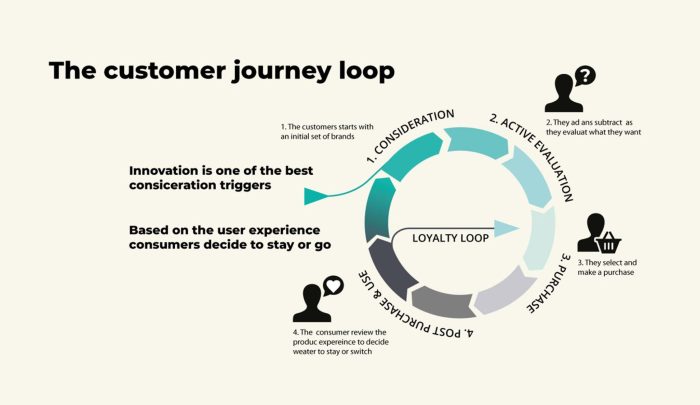Understanding the Customer Journey sets the stage for a thrilling exploration into the world of customer experience, where every interaction counts. Get ready to uncover the secrets behind customer behavior and the key touchpoints that shape their journey.
From mapping their journey to analyzing behavior and enhancing their experience, this guide will equip you with the tools and insights needed to create lasting connections with your customers.
Understanding the Customer Journey
The customer journey refers to the sum of all experiences that customers go through when interacting with a company or brand, from the initial awareness stage to the post-purchase stage.
Stages of the Customer Journey
- Awareness: This is the stage where potential customers become aware of the existence of a product or service.
- Consideration: At this stage, customers evaluate the options available to them before making a purchase decision.
- Decision: Customers make a decision to purchase a product or service based on their evaluation during the consideration stage.
- Retention: After making a purchase, customers assess their satisfaction with the product or service and decide whether to become repeat customers.
Touchpoints within the Customer Journey
- Website: Customers often visit a company’s website to gather information about products or services.
- Social Media: Interactions on social media platforms can influence customers’ perceptions and purchasing decisions.
- Customer Service: Positive or negative experiences with customer service representatives can impact the overall customer journey.
Mapping the Customer Journey
Mapping the customer journey is crucial for businesses to understand the various touchpoints a customer goes through when interacting with a product or service. By visualizing this journey, companies can identify pain points, opportunities for improvement, and optimize the overall customer experience.
The Importance of Mapping the Customer Journey
- Allows businesses to understand the customer’s perspective and tailor their marketing strategies accordingly.
- Helps in identifying areas where customers may drop off or face challenges, allowing for targeted interventions.
- Enables businesses to create a seamless and personalized experience for customers at every stage of their journey.
Methods for Creating a Customer Journey Map
- Conduct interviews, surveys, and research to gather insights from customers about their experiences.
- Utilize data analytics tools to track customer interactions and behavior across various channels.
- Create visual representations such as flowcharts or diagrams to map out the customer journey stages and touchpoints.
How Customer Personas Aid in Mapping the Customer Journey, Understanding the Customer Journey
- Customer personas are fictional representations of different customer segments based on demographics, behaviors, and preferences.
- By creating customer personas, businesses can better understand the needs and motivations of different customer groups.
- These personas can then be used to map out the customer journey for each segment, allowing for more targeted and effective strategies.
Analyzing Customer Behavior

Customer behavior analysis plays a crucial role in understanding the customer journey as it provides valuable insights into how customers interact with a product or service. By analyzing customer behavior, businesses can identify patterns, preferences, pain points, and opportunities for improvement along the customer journey.
Tools and Techniques for Analyzing Customer Behavior
- Customer Surveys: Gathering feedback directly from customers through surveys helps in understanding their preferences and pain points.
- Google Analytics: Tracking website data to analyze customer behavior, such as page views, bounce rates, and conversion rates.
- Social Media Monitoring: Monitoring social media platforms to gauge customer sentiment, interactions, and preferences.
- Heatmaps: Visualizing where customers click and scroll on a webpage to understand their behavior and engagement levels.
Identifying Pain Points in the Customer Journey
- Customer Support Interactions: Analyzing customer support tickets and complaints to pinpoint areas of dissatisfaction or confusion in the customer journey.
- Abandoned Cart Analysis: Examining reasons for cart abandonment to address issues that hinder the completion of a purchase.
- User Testing: Observing real users interacting with a product or service to uncover usability issues and pain points.
- Journey Mapping: Mapping out the entire customer journey to identify touchpoints where customers face challenges or obstacles.
Improving the Customer Experience

To enhance the customer experience, businesses can utilize insights gained from mapping the customer journey. By understanding the touchpoints and pain points of customers throughout their interaction with the brand, companies can tailor their strategies to better meet customer needs and expectations.
Personalized Communication and Offers
- Utilize customer data to personalize communication and offers, making customers feel valued and understood.
- Send targeted promotions based on past purchases or browsing behavior to increase engagement and loyalty.
- Implement loyalty programs that reward customers for their continued business, fostering a sense of belonging and appreciation.
Seamless Omnichannel Experience
- Ensure a seamless transition between online and offline channels, allowing customers to interact with the brand in their preferred way.
- Integrate customer data across channels to provide a cohesive experience and avoid repetition or confusion.
- Offer multiple touchpoints for customer support, such as chatbots, phone lines, and email, to cater to different preferences.
Continuous Feedback Loop
- Implement feedback mechanisms at various touchpoints to gather insights on customer satisfaction and pain points.
- Regularly analyze feedback data to identify trends and areas for improvement in the customer journey.
- Act on feedback by making necessary changes to processes, products, or services to address customer concerns and enhance the overall experience.
